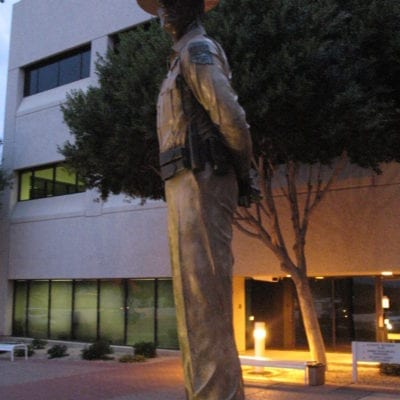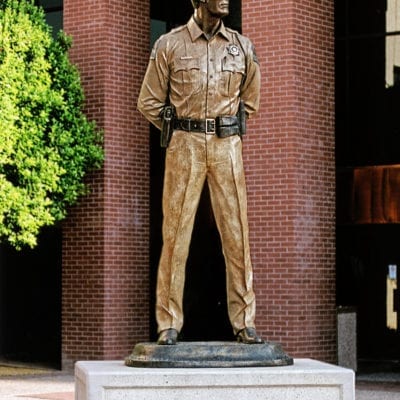Author: Lt. Dan Marcou
In recognition of the release of “Street Survival II: Tactics for Deadly Encounters,” I am writing a series of articles on street survival designed to turn the tables on the current generation of cop-killing criminals. In this series I will share the tactics I acquired during a career dedicated not only to ensuring my own personal survival, but assisting other officers in their quest to survive as well.
Any given year, approximately 12 percent of the police officers killed in the line of duty die performing what is often referred to as the “routine traffic stop.” The repetitive nature of such stops can make officers complacent. You can fight complacency caused by the “routine” by establishing a “tactical routine” oriented toward personal survival.
Practice a Prepared Response for a Sudden, Armed Assault
First, practice a prepared response to ensure your immediate reaction to a sudden, armed assault when it occurs:
- While seated in your squad; As you get out of your squad; As you reach the area between the vehicles; As you reach the side of the driver’s vehicle.
Choose a preferred tactical response for attacks at each of these positions and physically practice them often.
Vehicle Contact Survival Habits
Incorporate these procedures into every stop to inoculate yourself against complacency:
- Activate all cameras. Unedited footage is the professional officer’s best witness. Gather pre-stop intelligence by watching the activity in the vehicle before hitting the lights. Obtain registration information whenever possible prior to hitting the lights. Remind yourself as you hit the lights, “Pay attention! This is dangerous stuff!” Note and analyze the reaction of the driver and occupants when they realize you are behind them. The Supreme Court has recognized that “furtive movements” are indicators of danger. Make sure you recognize that as well. Choose the most advantageous squad-positioning tactic. The off-set position gives you a lane for a traditional approach, while angled gives a clear-cut cover option. The in-line position is utilized either where there is limited space, or for a high-risk stop. Use the PA to request the driver to re-position the vehicle if needed, or to turn on interior lights when they have tinted windows. This improves your visibility, while inhibiting theirs. This can be used as a compliance check as well. Glance to the rear before exiting (this is a very Important habit!) to make certain you are not endangered by oncoming traffic. Vary your approach between driver’s side and passenger side. Pause at the rear corner of the suspect’s vehicle and place your reaction hand palm down on the vehicle, leaving your prints in the event that the suspect flees, or worse. Assess what is transpiring in the vehicle, while conducting a mental inventory of what’s in plain view. Account for the hands by requesting, “Please place your hands palms up on the steering wheel.” Make your contact with the driver behind the center door post of the vehicle. Greet them, identify yourself and your agency/authority, and detail the reason for the stop. Don’t be rude, because it gives them ammo to turn the tables on you later. Request their driver’s license and registration. If they do not have it handy, verify where they will be reaching to get it. Watch and control the speed of the entire reach and, if they must open a compartment, visually clear it before they reach in. Hold the license in your non-gun hand. Verify the information on the license, while visually comparing the license’s photo and description – especially eye color – with the driver. Advise them of your decision to cite or warn and pay attention to their reaction, as well as oncoming traffic, while you return to your vehicle. Pay attention to the activities of the occupants while preparing the paperwork. Run checks on the driver and all occupants of the vehicle that you have information on. Repeat your initial caution on the return. Consider re-contacting the driver at the opposite window from the initial contact. Account for hands and scan for changes. Deliver the paperwork from behind the center post. If they are angry, don’t reflect their anger. Eldon Mueller once said, “The man who angers you conquers you.” George Thompson would add, “Let them say what they want as long as they do what you say.” Consider ending the contact with “Thank you for your courtesy,” if they earned it and/or “Drive carefully.” Don’t say, “Have a nice day!” Assist them back into traffic if necessary. Complete your paperwork elsewhere to avoid a return-to-confront situation.
The Magic Questions to ask on Every Traffic Stop
Since every stop is an investigation, you can ask these questions of the occupants nonchalantly and separately. Then compare their answers to determine the veracity of each:
- Who are you? Who are they? Where are you coming from? Oh really? What did you do there? Where are you headed? Oh really? What will you do when you get there?
Differing answers indicate deception, which can be an indicator something nefarious is afoot.
Transition
Any approach to make a vehicle contact can suddenly rachet up to something more because:
- You detect indications of impairment; You are met with non-compliance and/or belligerence; You verify outstanding warrants; You uncover probable cause of a crime; You are presented with an imminent threat.
In each of these cases it behooves you to at the very least call for back-up and possibly transition to a non-approach stop, where you call the suspect out to a spot where he is visible to you, but you are not readily visible to him. The situation may even warrant transitioning into a high-risk stop during which the occupants are called back out and back to you one at a time with their hands up and facing away from you. The imminent threat would require immediate justifiable action.
Conclusion
Going into most vehicle contacts you are at a disadvantage. You do not know what the occupants of the vehicle are all about, but they do. Using solid tactics “routinely” will heighten your awareness and elevate your preparedness throughout every stop you make.
With all that said, pay attention out there! This is dangerous stuff!
LEARN MORE
Street survival: Develop your stealth approach
Street survival: Premonition of a multiple assailant attack comes true
“Street Survival II” offers survival strategies for all LEOs






